Science and Materials Report: HNC/HND Construction Project Analysis
VerifiedAdded on 2023/04/22
|16
|4347
|355
Report
AI Summary
This report, prepared for a construction project, examines various aspects of science and materials within the construction industry. It begins with a site layout sketch and discusses the materials needed for building preparation, demolition, and construction, emphasizing the importance of designated storage, proper handling, and personal protective equipment. The report then details health hazards associated with materials like lead, solvents, VOCs, fiberglass, PVC, and silica, along with crucial precautionary measures, including risk assessment and adherence to regulations. The analysis extends to the environmental and sustainability benefits of structural steel, comparing past and present building materials. Furthermore, it compares the advantages and disadvantages of steel, concrete, and wood columns, advocating for wood as a more sustainable alternative. The report concludes by outlining applicable standards for structural wood and the testing procedures for assessing its strength. The report provides a comprehensive overview of materials, health and safety practices, and sustainable construction methods.
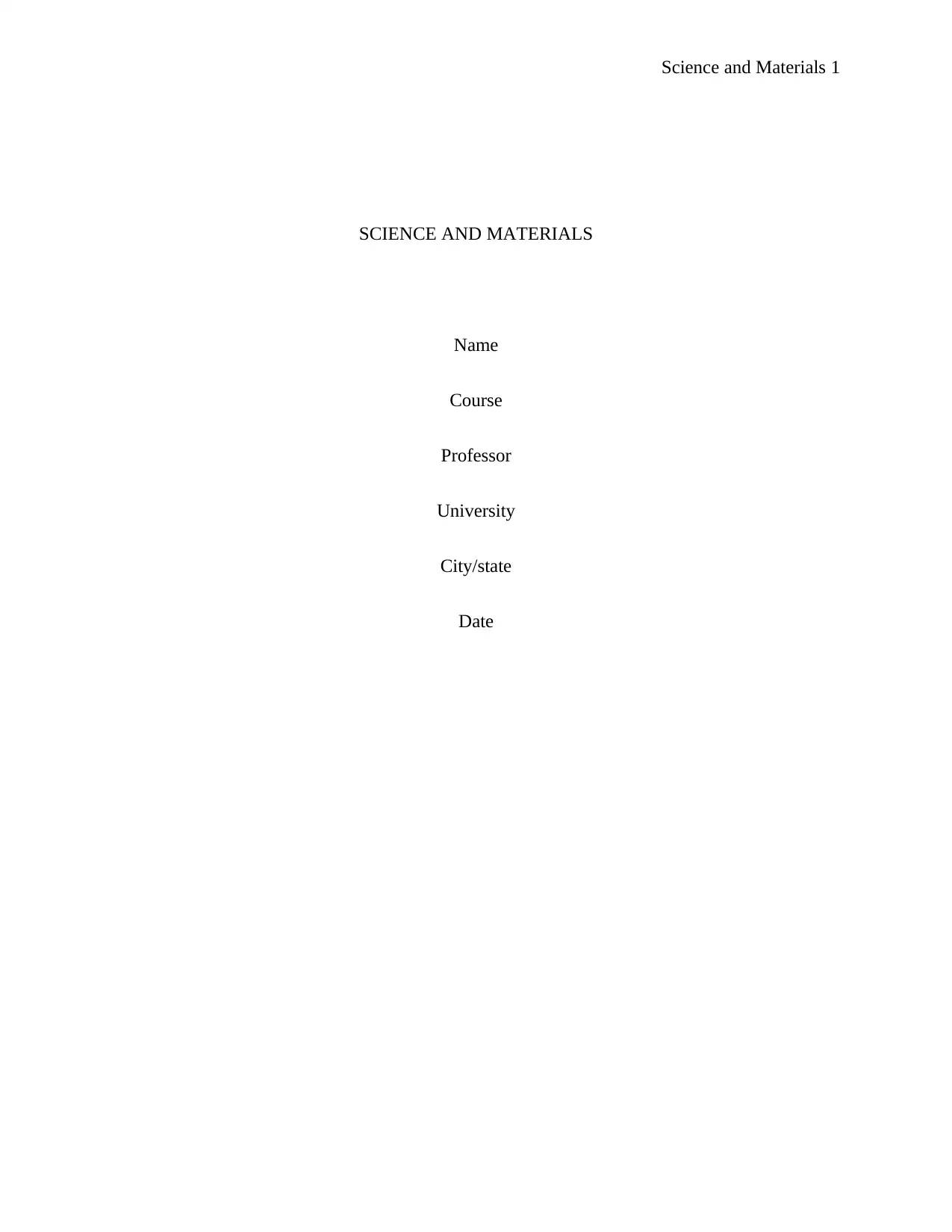
Science and Materials 1
SCIENCE AND MATERIALS
Name
Course
Professor
University
City/state
Date
SCIENCE AND MATERIALS
Name
Course
Professor
University
City/state
Date
Paraphrase This Document
Need a fresh take? Get an instant paraphrase of this document with our AI Paraphraser
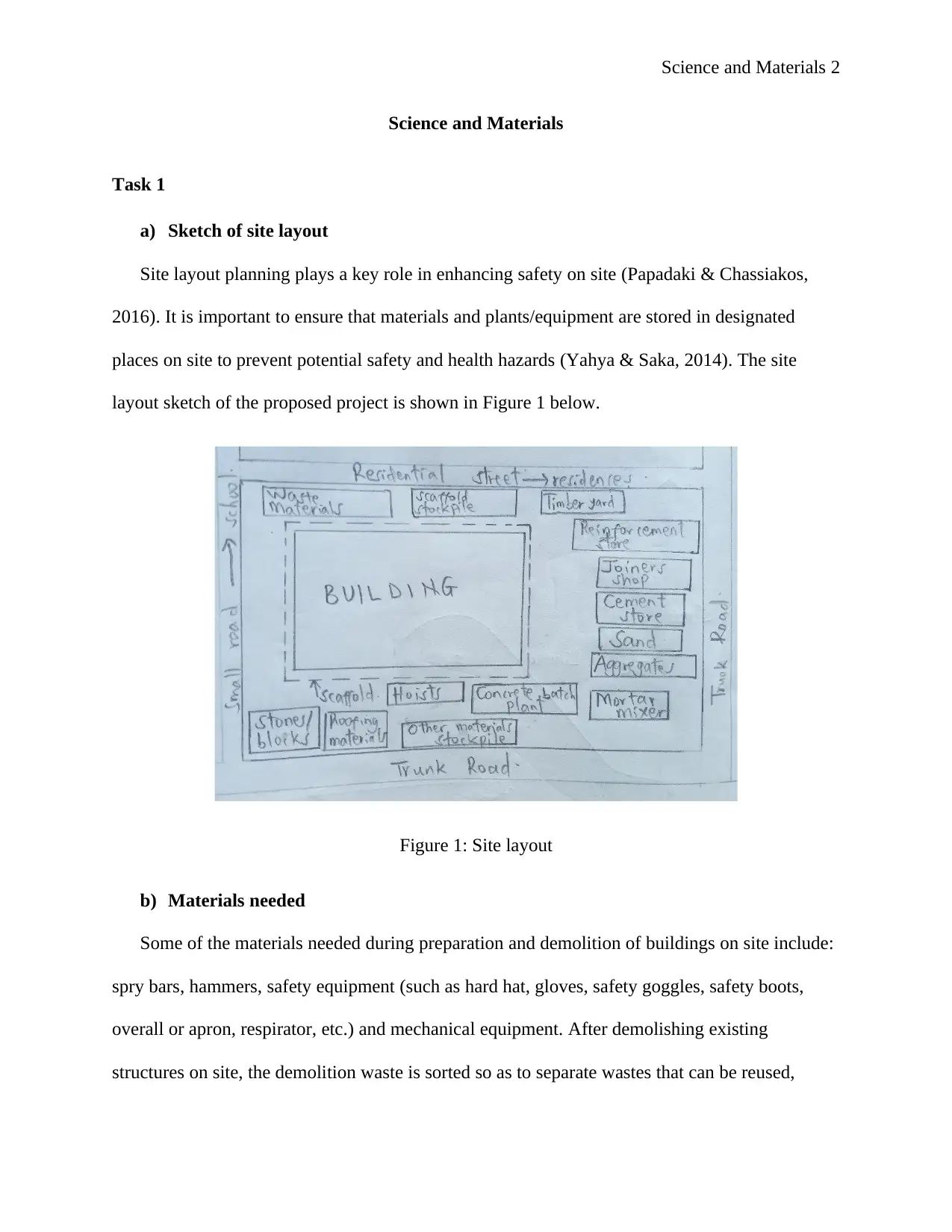
Science and Materials 2
Science and Materials
Task 1
a) Sketch of site layout
Site layout planning plays a key role in enhancing safety on site (Papadaki & Chassiakos,
2016). It is important to ensure that materials and plants/equipment are stored in designated
places on site to prevent potential safety and health hazards (Yahya & Saka, 2014). The site
layout sketch of the proposed project is shown in Figure 1 below.
Figure 1: Site layout
b) Materials needed
Some of the materials needed during preparation and demolition of buildings on site include:
spry bars, hammers, safety equipment (such as hard hat, gloves, safety goggles, safety boots,
overall or apron, respirator, etc.) and mechanical equipment. After demolishing existing
structures on site, the demolition waste is sorted so as to separate wastes that can be reused,
Science and Materials
Task 1
a) Sketch of site layout
Site layout planning plays a key role in enhancing safety on site (Papadaki & Chassiakos,
2016). It is important to ensure that materials and plants/equipment are stored in designated
places on site to prevent potential safety and health hazards (Yahya & Saka, 2014). The site
layout sketch of the proposed project is shown in Figure 1 below.
Figure 1: Site layout
b) Materials needed
Some of the materials needed during preparation and demolition of buildings on site include:
spry bars, hammers, safety equipment (such as hard hat, gloves, safety goggles, safety boots,
overall or apron, respirator, etc.) and mechanical equipment. After demolishing existing
structures on site, the demolition waste is sorted so as to separate wastes that can be reused,
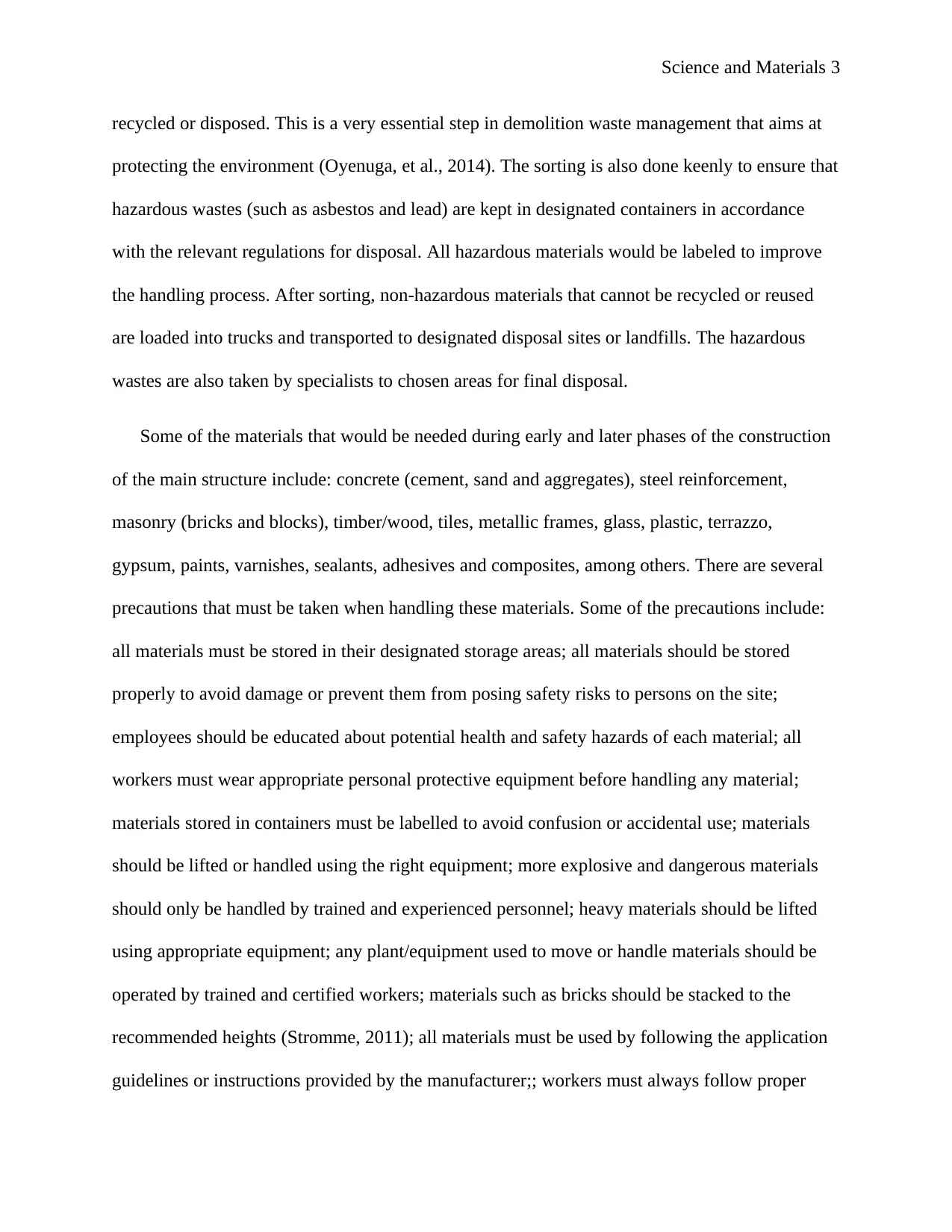
Science and Materials 3
recycled or disposed. This is a very essential step in demolition waste management that aims at
protecting the environment (Oyenuga, et al., 2014). The sorting is also done keenly to ensure that
hazardous wastes (such as asbestos and lead) are kept in designated containers in accordance
with the relevant regulations for disposal. All hazardous materials would be labeled to improve
the handling process. After sorting, non-hazardous materials that cannot be recycled or reused
are loaded into trucks and transported to designated disposal sites or landfills. The hazardous
wastes are also taken by specialists to chosen areas for final disposal.
Some of the materials that would be needed during early and later phases of the construction
of the main structure include: concrete (cement, sand and aggregates), steel reinforcement,
masonry (bricks and blocks), timber/wood, tiles, metallic frames, glass, plastic, terrazzo,
gypsum, paints, varnishes, sealants, adhesives and composites, among others. There are several
precautions that must be taken when handling these materials. Some of the precautions include:
all materials must be stored in their designated storage areas; all materials should be stored
properly to avoid damage or prevent them from posing safety risks to persons on the site;
employees should be educated about potential health and safety hazards of each material; all
workers must wear appropriate personal protective equipment before handling any material;
materials stored in containers must be labelled to avoid confusion or accidental use; materials
should be lifted or handled using the right equipment; more explosive and dangerous materials
should only be handled by trained and experienced personnel; heavy materials should be lifted
using appropriate equipment; any plant/equipment used to move or handle materials should be
operated by trained and certified workers; materials such as bricks should be stacked to the
recommended heights (Stromme, 2011); all materials must be used by following the application
guidelines or instructions provided by the manufacturer;; workers must always follow proper
recycled or disposed. This is a very essential step in demolition waste management that aims at
protecting the environment (Oyenuga, et al., 2014). The sorting is also done keenly to ensure that
hazardous wastes (such as asbestos and lead) are kept in designated containers in accordance
with the relevant regulations for disposal. All hazardous materials would be labeled to improve
the handling process. After sorting, non-hazardous materials that cannot be recycled or reused
are loaded into trucks and transported to designated disposal sites or landfills. The hazardous
wastes are also taken by specialists to chosen areas for final disposal.
Some of the materials that would be needed during early and later phases of the construction
of the main structure include: concrete (cement, sand and aggregates), steel reinforcement,
masonry (bricks and blocks), timber/wood, tiles, metallic frames, glass, plastic, terrazzo,
gypsum, paints, varnishes, sealants, adhesives and composites, among others. There are several
precautions that must be taken when handling these materials. Some of the precautions include:
all materials must be stored in their designated storage areas; all materials should be stored
properly to avoid damage or prevent them from posing safety risks to persons on the site;
employees should be educated about potential health and safety hazards of each material; all
workers must wear appropriate personal protective equipment before handling any material;
materials stored in containers must be labelled to avoid confusion or accidental use; materials
should be lifted or handled using the right equipment; more explosive and dangerous materials
should only be handled by trained and experienced personnel; heavy materials should be lifted
using appropriate equipment; any plant/equipment used to move or handle materials should be
operated by trained and certified workers; materials such as bricks should be stacked to the
recommended heights (Stromme, 2011); all materials must be used by following the application
guidelines or instructions provided by the manufacturer;; workers must always follow proper
⊘ This is a preview!⊘
Do you want full access?
Subscribe today to unlock all pages.

Trusted by 1+ million students worldwide
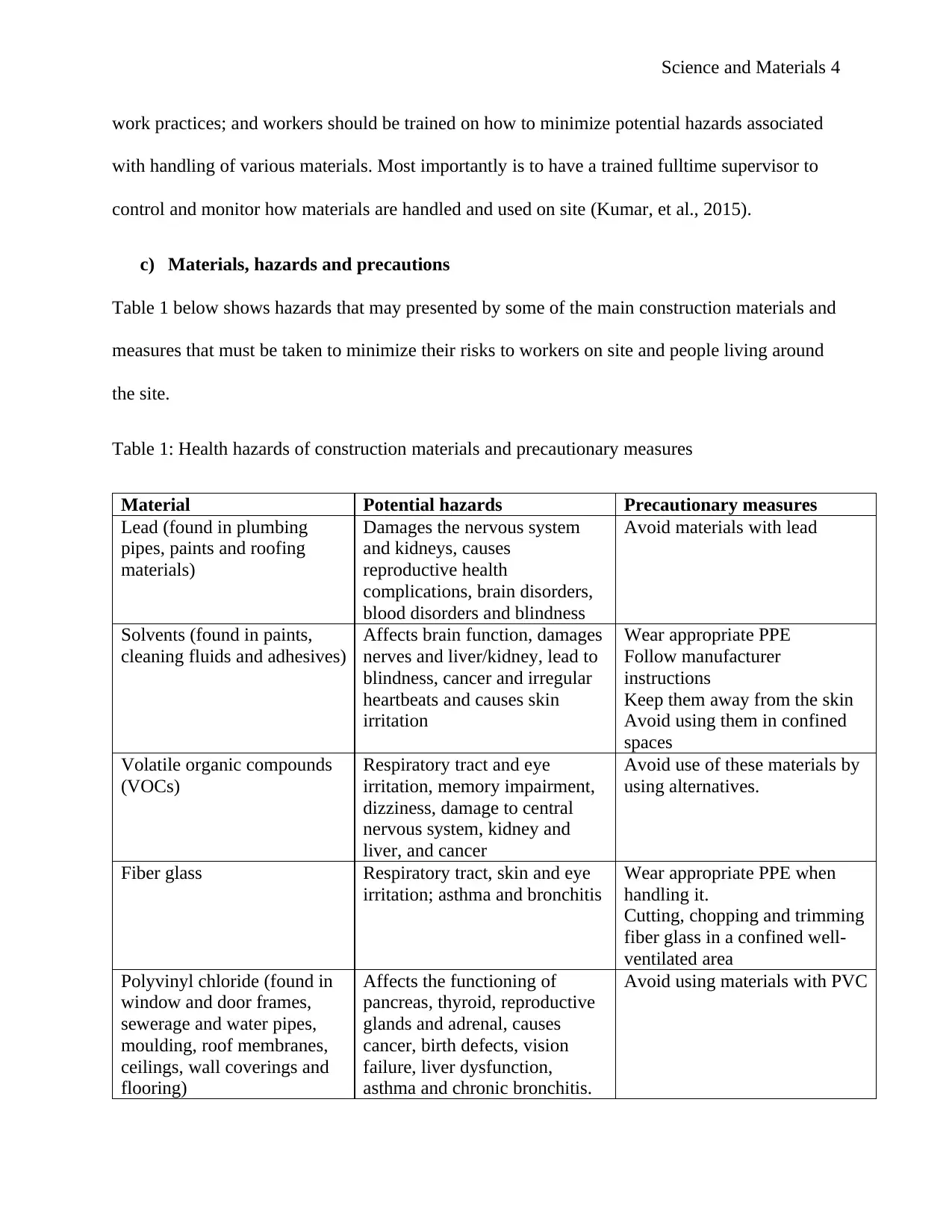
Science and Materials 4
work practices; and workers should be trained on how to minimize potential hazards associated
with handling of various materials. Most importantly is to have a trained fulltime supervisor to
control and monitor how materials are handled and used on site (Kumar, et al., 2015).
c) Materials, hazards and precautions
Table 1 below shows hazards that may presented by some of the main construction materials and
measures that must be taken to minimize their risks to workers on site and people living around
the site.
Table 1: Health hazards of construction materials and precautionary measures
Material Potential hazards Precautionary measures
Lead (found in plumbing
pipes, paints and roofing
materials)
Damages the nervous system
and kidneys, causes
reproductive health
complications, brain disorders,
blood disorders and blindness
Avoid materials with lead
Solvents (found in paints,
cleaning fluids and adhesives)
Affects brain function, damages
nerves and liver/kidney, lead to
blindness, cancer and irregular
heartbeats and causes skin
irritation
Wear appropriate PPE
Follow manufacturer
instructions
Keep them away from the skin
Avoid using them in confined
spaces
Volatile organic compounds
(VOCs)
Respiratory tract and eye
irritation, memory impairment,
dizziness, damage to central
nervous system, kidney and
liver, and cancer
Avoid use of these materials by
using alternatives.
Fiber glass Respiratory tract, skin and eye
irritation; asthma and bronchitis
Wear appropriate PPE when
handling it.
Cutting, chopping and trimming
fiber glass in a confined well-
ventilated area
Polyvinyl chloride (found in
window and door frames,
sewerage and water pipes,
moulding, roof membranes,
ceilings, wall coverings and
flooring)
Affects the functioning of
pancreas, thyroid, reproductive
glands and adrenal, causes
cancer, birth defects, vision
failure, liver dysfunction,
asthma and chronic bronchitis.
Avoid using materials with PVC
work practices; and workers should be trained on how to minimize potential hazards associated
with handling of various materials. Most importantly is to have a trained fulltime supervisor to
control and monitor how materials are handled and used on site (Kumar, et al., 2015).
c) Materials, hazards and precautions
Table 1 below shows hazards that may presented by some of the main construction materials and
measures that must be taken to minimize their risks to workers on site and people living around
the site.
Table 1: Health hazards of construction materials and precautionary measures
Material Potential hazards Precautionary measures
Lead (found in plumbing
pipes, paints and roofing
materials)
Damages the nervous system
and kidneys, causes
reproductive health
complications, brain disorders,
blood disorders and blindness
Avoid materials with lead
Solvents (found in paints,
cleaning fluids and adhesives)
Affects brain function, damages
nerves and liver/kidney, lead to
blindness, cancer and irregular
heartbeats and causes skin
irritation
Wear appropriate PPE
Follow manufacturer
instructions
Keep them away from the skin
Avoid using them in confined
spaces
Volatile organic compounds
(VOCs)
Respiratory tract and eye
irritation, memory impairment,
dizziness, damage to central
nervous system, kidney and
liver, and cancer
Avoid use of these materials by
using alternatives.
Fiber glass Respiratory tract, skin and eye
irritation; asthma and bronchitis
Wear appropriate PPE when
handling it.
Cutting, chopping and trimming
fiber glass in a confined well-
ventilated area
Polyvinyl chloride (found in
window and door frames,
sewerage and water pipes,
moulding, roof membranes,
ceilings, wall coverings and
flooring)
Affects the functioning of
pancreas, thyroid, reproductive
glands and adrenal, causes
cancer, birth defects, vision
failure, liver dysfunction,
asthma and chronic bronchitis.
Avoid using materials with PVC
Paraphrase This Document
Need a fresh take? Get an instant paraphrase of this document with our AI Paraphraser
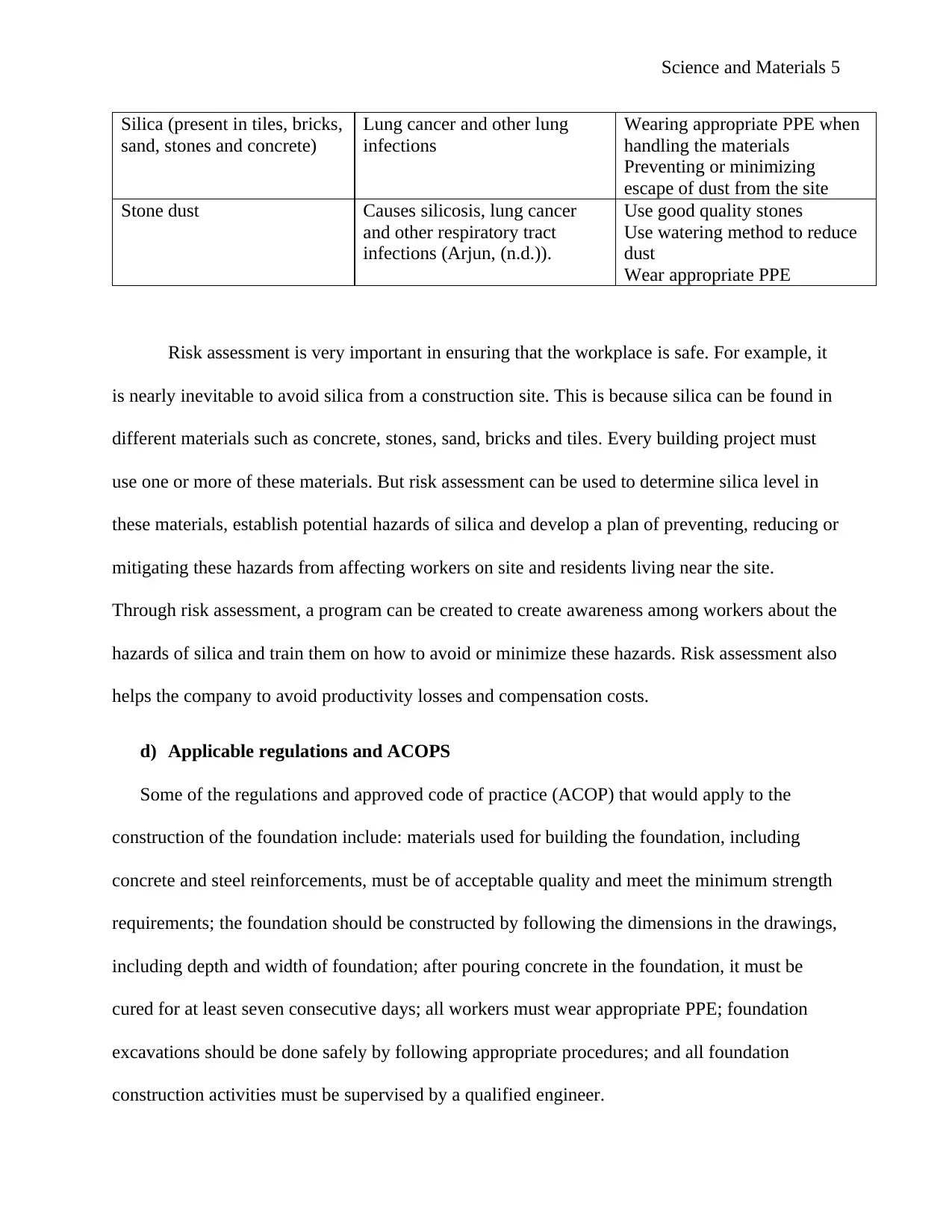
Science and Materials 5
Silica (present in tiles, bricks,
sand, stones and concrete)
Lung cancer and other lung
infections
Wearing appropriate PPE when
handling the materials
Preventing or minimizing
escape of dust from the site
Stone dust Causes silicosis, lung cancer
and other respiratory tract
infections (Arjun, (n.d.)).
Use good quality stones
Use watering method to reduce
dust
Wear appropriate PPE
Risk assessment is very important in ensuring that the workplace is safe. For example, it
is nearly inevitable to avoid silica from a construction site. This is because silica can be found in
different materials such as concrete, stones, sand, bricks and tiles. Every building project must
use one or more of these materials. But risk assessment can be used to determine silica level in
these materials, establish potential hazards of silica and develop a plan of preventing, reducing or
mitigating these hazards from affecting workers on site and residents living near the site.
Through risk assessment, a program can be created to create awareness among workers about the
hazards of silica and train them on how to avoid or minimize these hazards. Risk assessment also
helps the company to avoid productivity losses and compensation costs.
d) Applicable regulations and ACOPS
Some of the regulations and approved code of practice (ACOP) that would apply to the
construction of the foundation include: materials used for building the foundation, including
concrete and steel reinforcements, must be of acceptable quality and meet the minimum strength
requirements; the foundation should be constructed by following the dimensions in the drawings,
including depth and width of foundation; after pouring concrete in the foundation, it must be
cured for at least seven consecutive days; all workers must wear appropriate PPE; foundation
excavations should be done safely by following appropriate procedures; and all foundation
construction activities must be supervised by a qualified engineer.
Silica (present in tiles, bricks,
sand, stones and concrete)
Lung cancer and other lung
infections
Wearing appropriate PPE when
handling the materials
Preventing or minimizing
escape of dust from the site
Stone dust Causes silicosis, lung cancer
and other respiratory tract
infections (Arjun, (n.d.)).
Use good quality stones
Use watering method to reduce
dust
Wear appropriate PPE
Risk assessment is very important in ensuring that the workplace is safe. For example, it
is nearly inevitable to avoid silica from a construction site. This is because silica can be found in
different materials such as concrete, stones, sand, bricks and tiles. Every building project must
use one or more of these materials. But risk assessment can be used to determine silica level in
these materials, establish potential hazards of silica and develop a plan of preventing, reducing or
mitigating these hazards from affecting workers on site and residents living near the site.
Through risk assessment, a program can be created to create awareness among workers about the
hazards of silica and train them on how to avoid or minimize these hazards. Risk assessment also
helps the company to avoid productivity losses and compensation costs.
d) Applicable regulations and ACOPS
Some of the regulations and approved code of practice (ACOP) that would apply to the
construction of the foundation include: materials used for building the foundation, including
concrete and steel reinforcements, must be of acceptable quality and meet the minimum strength
requirements; the foundation should be constructed by following the dimensions in the drawings,
including depth and width of foundation; after pouring concrete in the foundation, it must be
cured for at least seven consecutive days; all workers must wear appropriate PPE; foundation
excavations should be done safely by following appropriate procedures; and all foundation
construction activities must be supervised by a qualified engineer.
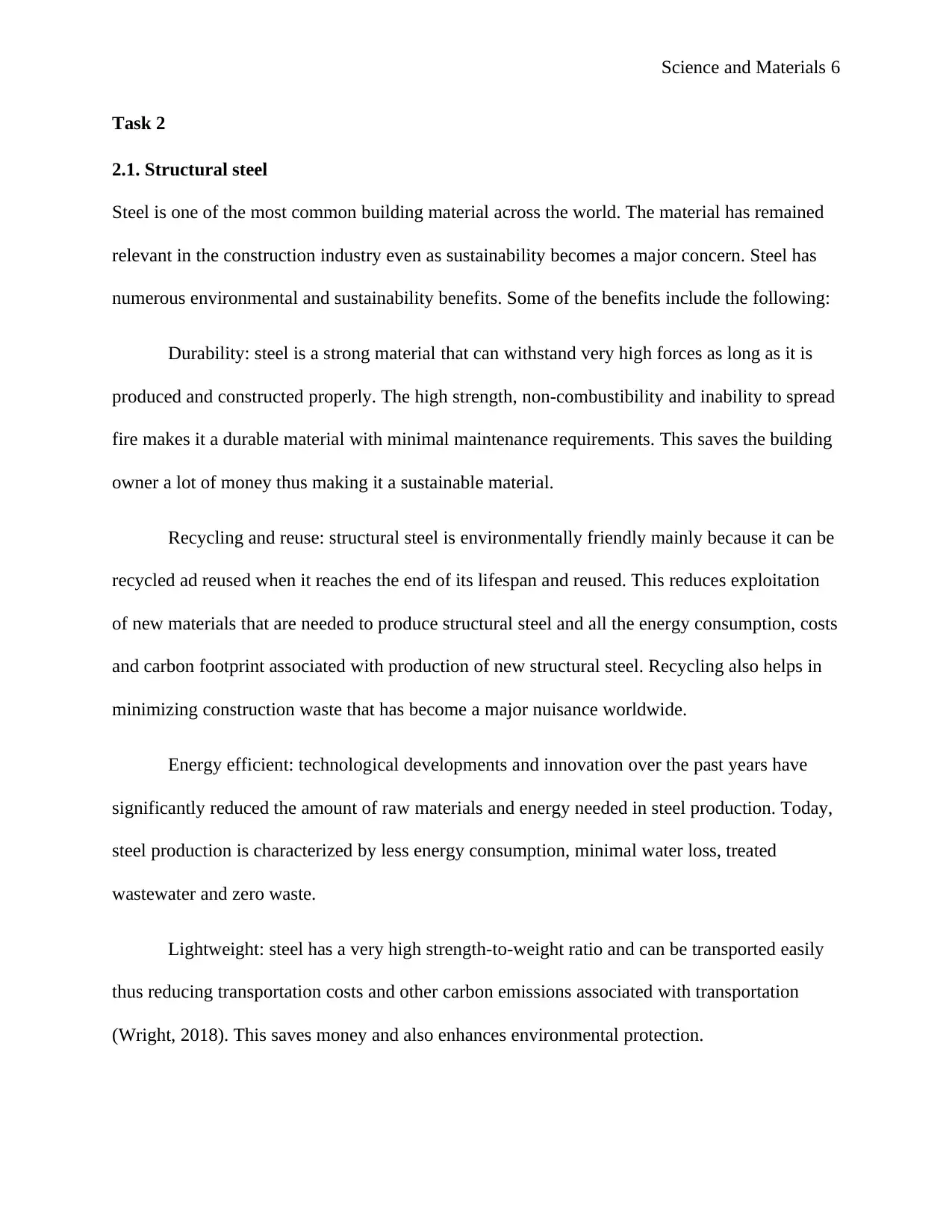
Science and Materials 6
Task 2
2.1. Structural steel
Steel is one of the most common building material across the world. The material has remained
relevant in the construction industry even as sustainability becomes a major concern. Steel has
numerous environmental and sustainability benefits. Some of the benefits include the following:
Durability: steel is a strong material that can withstand very high forces as long as it is
produced and constructed properly. The high strength, non-combustibility and inability to spread
fire makes it a durable material with minimal maintenance requirements. This saves the building
owner a lot of money thus making it a sustainable material.
Recycling and reuse: structural steel is environmentally friendly mainly because it can be
recycled ad reused when it reaches the end of its lifespan and reused. This reduces exploitation
of new materials that are needed to produce structural steel and all the energy consumption, costs
and carbon footprint associated with production of new structural steel. Recycling also helps in
minimizing construction waste that has become a major nuisance worldwide.
Energy efficient: technological developments and innovation over the past years have
significantly reduced the amount of raw materials and energy needed in steel production. Today,
steel production is characterized by less energy consumption, minimal water loss, treated
wastewater and zero waste.
Lightweight: steel has a very high strength-to-weight ratio and can be transported easily
thus reducing transportation costs and other carbon emissions associated with transportation
(Wright, 2018). This saves money and also enhances environmental protection.
Task 2
2.1. Structural steel
Steel is one of the most common building material across the world. The material has remained
relevant in the construction industry even as sustainability becomes a major concern. Steel has
numerous environmental and sustainability benefits. Some of the benefits include the following:
Durability: steel is a strong material that can withstand very high forces as long as it is
produced and constructed properly. The high strength, non-combustibility and inability to spread
fire makes it a durable material with minimal maintenance requirements. This saves the building
owner a lot of money thus making it a sustainable material.
Recycling and reuse: structural steel is environmentally friendly mainly because it can be
recycled ad reused when it reaches the end of its lifespan and reused. This reduces exploitation
of new materials that are needed to produce structural steel and all the energy consumption, costs
and carbon footprint associated with production of new structural steel. Recycling also helps in
minimizing construction waste that has become a major nuisance worldwide.
Energy efficient: technological developments and innovation over the past years have
significantly reduced the amount of raw materials and energy needed in steel production. Today,
steel production is characterized by less energy consumption, minimal water loss, treated
wastewater and zero waste.
Lightweight: steel has a very high strength-to-weight ratio and can be transported easily
thus reducing transportation costs and other carbon emissions associated with transportation
(Wright, 2018). This saves money and also enhances environmental protection.
⊘ This is a preview!⊘
Do you want full access?
Subscribe today to unlock all pages.

Trusted by 1+ million students worldwide

Science and Materials 7
Prefabrication: steel is a versatile material that can be prefabricated offsite to reduce time
and cost of construction and wastage.
However, steel also has some disadvantages. Some of these perceived disadvantages of
structural steel include: it is susceptible to corrosion; it requires costly fireproof treatment to
withstand very high temperatures; it is difficult to be molded in any other direction other than its
original form sections; and it is susceptible to fatigue and brittle fracture. The good news is that
numerous engineering solutions have been developed to overcome these disadvantages. But
clearly there is no disadvantage that has a direct effect on the environmental friendliness and
sustainability of steel.
Therefore structural steel is an environmentally friendly building material because of
sustainable production, sustainable transportation, sustainable construction, recycling and reuse.
Some of the materials that may be used to construct such a structure 50 years ago and the
ones used today are provided in Table 2 below:
Table 2: Comparison of past and present materials
Materials used 50 years ago Materials used today
Bamboo Structural steel or wood
Adobe bricks or limestone bricks Blocks
Cob Mortar
Straw-clay Timber or plasterboards
Grass Roofing tiles
Wood shingles or metal shingles Clay tiles, architectural shingles, slate and corrugated metal
panels
Asphalt Galvanized iron sheets or concrete tiles
Slate tiles Composites, synthetic slates
Bitumen PVC roofing
Prefabrication: steel is a versatile material that can be prefabricated offsite to reduce time
and cost of construction and wastage.
However, steel also has some disadvantages. Some of these perceived disadvantages of
structural steel include: it is susceptible to corrosion; it requires costly fireproof treatment to
withstand very high temperatures; it is difficult to be molded in any other direction other than its
original form sections; and it is susceptible to fatigue and brittle fracture. The good news is that
numerous engineering solutions have been developed to overcome these disadvantages. But
clearly there is no disadvantage that has a direct effect on the environmental friendliness and
sustainability of steel.
Therefore structural steel is an environmentally friendly building material because of
sustainable production, sustainable transportation, sustainable construction, recycling and reuse.
Some of the materials that may be used to construct such a structure 50 years ago and the
ones used today are provided in Table 2 below:
Table 2: Comparison of past and present materials
Materials used 50 years ago Materials used today
Bamboo Structural steel or wood
Adobe bricks or limestone bricks Blocks
Cob Mortar
Straw-clay Timber or plasterboards
Grass Roofing tiles
Wood shingles or metal shingles Clay tiles, architectural shingles, slate and corrugated metal
panels
Asphalt Galvanized iron sheets or concrete tiles
Slate tiles Composites, synthetic slates
Bitumen PVC roofing
Paraphrase This Document
Need a fresh take? Get an instant paraphrase of this document with our AI Paraphraser
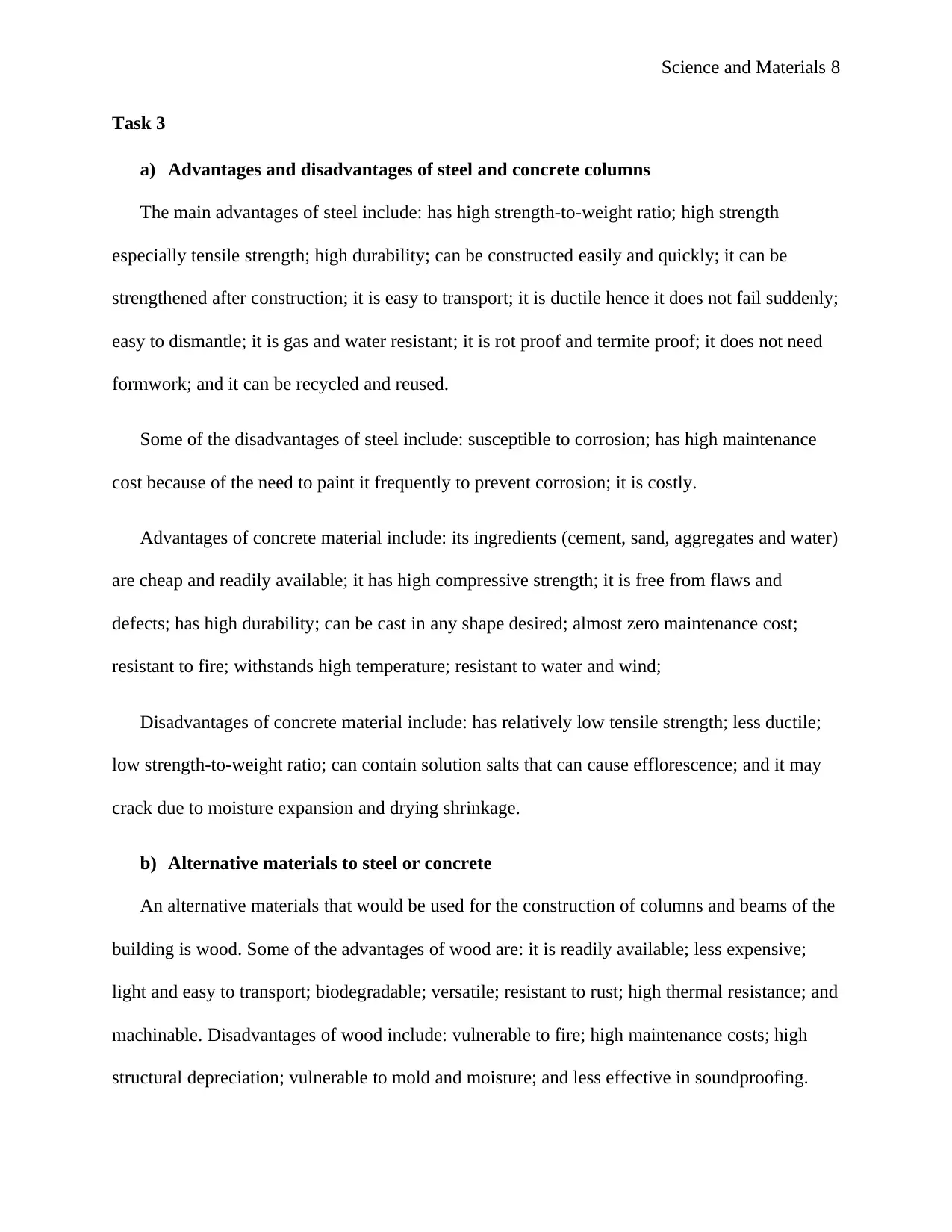
Science and Materials 8
Task 3
a) Advantages and disadvantages of steel and concrete columns
The main advantages of steel include: has high strength-to-weight ratio; high strength
especially tensile strength; high durability; can be constructed easily and quickly; it can be
strengthened after construction; it is easy to transport; it is ductile hence it does not fail suddenly;
easy to dismantle; it is gas and water resistant; it is rot proof and termite proof; it does not need
formwork; and it can be recycled and reused.
Some of the disadvantages of steel include: susceptible to corrosion; has high maintenance
cost because of the need to paint it frequently to prevent corrosion; it is costly.
Advantages of concrete material include: its ingredients (cement, sand, aggregates and water)
are cheap and readily available; it has high compressive strength; it is free from flaws and
defects; has high durability; can be cast in any shape desired; almost zero maintenance cost;
resistant to fire; withstands high temperature; resistant to water and wind;
Disadvantages of concrete material include: has relatively low tensile strength; less ductile;
low strength-to-weight ratio; can contain solution salts that can cause efflorescence; and it may
crack due to moisture expansion and drying shrinkage.
b) Alternative materials to steel or concrete
An alternative materials that would be used for the construction of columns and beams of the
building is wood. Some of the advantages of wood are: it is readily available; less expensive;
light and easy to transport; biodegradable; versatile; resistant to rust; high thermal resistance; and
machinable. Disadvantages of wood include: vulnerable to fire; high maintenance costs; high
structural depreciation; vulnerable to mold and moisture; and less effective in soundproofing.
Task 3
a) Advantages and disadvantages of steel and concrete columns
The main advantages of steel include: has high strength-to-weight ratio; high strength
especially tensile strength; high durability; can be constructed easily and quickly; it can be
strengthened after construction; it is easy to transport; it is ductile hence it does not fail suddenly;
easy to dismantle; it is gas and water resistant; it is rot proof and termite proof; it does not need
formwork; and it can be recycled and reused.
Some of the disadvantages of steel include: susceptible to corrosion; has high maintenance
cost because of the need to paint it frequently to prevent corrosion; it is costly.
Advantages of concrete material include: its ingredients (cement, sand, aggregates and water)
are cheap and readily available; it has high compressive strength; it is free from flaws and
defects; has high durability; can be cast in any shape desired; almost zero maintenance cost;
resistant to fire; withstands high temperature; resistant to water and wind;
Disadvantages of concrete material include: has relatively low tensile strength; less ductile;
low strength-to-weight ratio; can contain solution salts that can cause efflorescence; and it may
crack due to moisture expansion and drying shrinkage.
b) Alternative materials to steel or concrete
An alternative materials that would be used for the construction of columns and beams of the
building is wood. Some of the advantages of wood are: it is readily available; less expensive;
light and easy to transport; biodegradable; versatile; resistant to rust; high thermal resistance; and
machinable. Disadvantages of wood include: vulnerable to fire; high maintenance costs; high
structural depreciation; vulnerable to mold and moisture; and less effective in soundproofing.
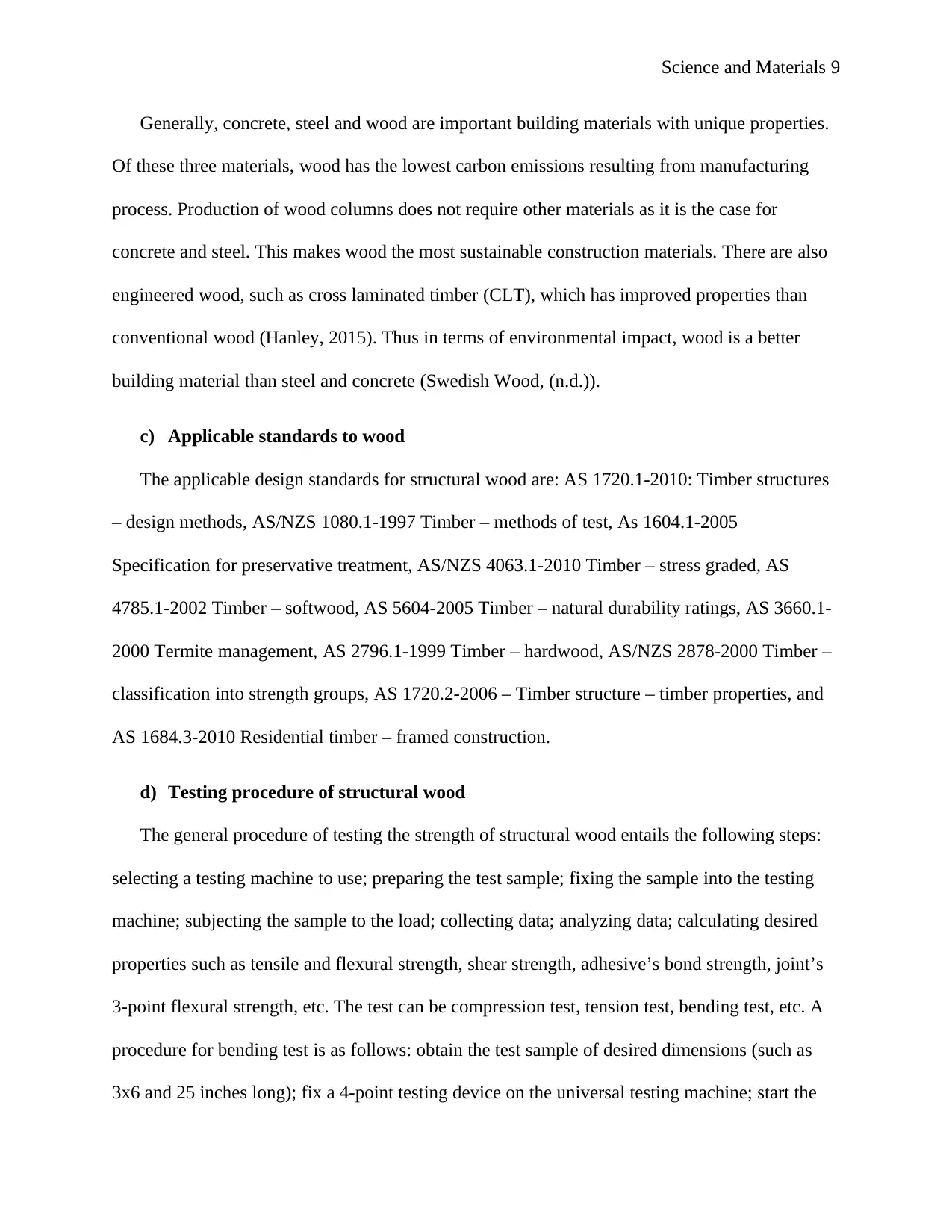
Science and Materials 9
Generally, concrete, steel and wood are important building materials with unique properties.
Of these three materials, wood has the lowest carbon emissions resulting from manufacturing
process. Production of wood columns does not require other materials as it is the case for
concrete and steel. This makes wood the most sustainable construction materials. There are also
engineered wood, such as cross laminated timber (CLT), which has improved properties than
conventional wood (Hanley, 2015). Thus in terms of environmental impact, wood is a better
building material than steel and concrete (Swedish Wood, (n.d.)).
c) Applicable standards to wood
The applicable design standards for structural wood are: AS 1720.1-2010: Timber structures
– design methods, AS/NZS 1080.1-1997 Timber – methods of test, As 1604.1-2005
Specification for preservative treatment, AS/NZS 4063.1-2010 Timber – stress graded, AS
4785.1-2002 Timber – softwood, AS 5604-2005 Timber – natural durability ratings, AS 3660.1-
2000 Termite management, AS 2796.1-1999 Timber – hardwood, AS/NZS 2878-2000 Timber –
classification into strength groups, AS 1720.2-2006 – Timber structure – timber properties, and
AS 1684.3-2010 Residential timber – framed construction.
d) Testing procedure of structural wood
The general procedure of testing the strength of structural wood entails the following steps:
selecting a testing machine to use; preparing the test sample; fixing the sample into the testing
machine; subjecting the sample to the load; collecting data; analyzing data; calculating desired
properties such as tensile and flexural strength, shear strength, adhesive’s bond strength, joint’s
3-point flexural strength, etc. The test can be compression test, tension test, bending test, etc. A
procedure for bending test is as follows: obtain the test sample of desired dimensions (such as
3x6 and 25 inches long); fix a 4-point testing device on the universal testing machine; start the
Generally, concrete, steel and wood are important building materials with unique properties.
Of these three materials, wood has the lowest carbon emissions resulting from manufacturing
process. Production of wood columns does not require other materials as it is the case for
concrete and steel. This makes wood the most sustainable construction materials. There are also
engineered wood, such as cross laminated timber (CLT), which has improved properties than
conventional wood (Hanley, 2015). Thus in terms of environmental impact, wood is a better
building material than steel and concrete (Swedish Wood, (n.d.)).
c) Applicable standards to wood
The applicable design standards for structural wood are: AS 1720.1-2010: Timber structures
– design methods, AS/NZS 1080.1-1997 Timber – methods of test, As 1604.1-2005
Specification for preservative treatment, AS/NZS 4063.1-2010 Timber – stress graded, AS
4785.1-2002 Timber – softwood, AS 5604-2005 Timber – natural durability ratings, AS 3660.1-
2000 Termite management, AS 2796.1-1999 Timber – hardwood, AS/NZS 2878-2000 Timber –
classification into strength groups, AS 1720.2-2006 – Timber structure – timber properties, and
AS 1684.3-2010 Residential timber – framed construction.
d) Testing procedure of structural wood
The general procedure of testing the strength of structural wood entails the following steps:
selecting a testing machine to use; preparing the test sample; fixing the sample into the testing
machine; subjecting the sample to the load; collecting data; analyzing data; calculating desired
properties such as tensile and flexural strength, shear strength, adhesive’s bond strength, joint’s
3-point flexural strength, etc. The test can be compression test, tension test, bending test, etc. A
procedure for bending test is as follows: obtain the test sample of desired dimensions (such as
3x6 and 25 inches long); fix a 4-point testing device on the universal testing machine; start the
⊘ This is a preview!⊘
Do you want full access?
Subscribe today to unlock all pages.

Trusted by 1+ million students worldwide
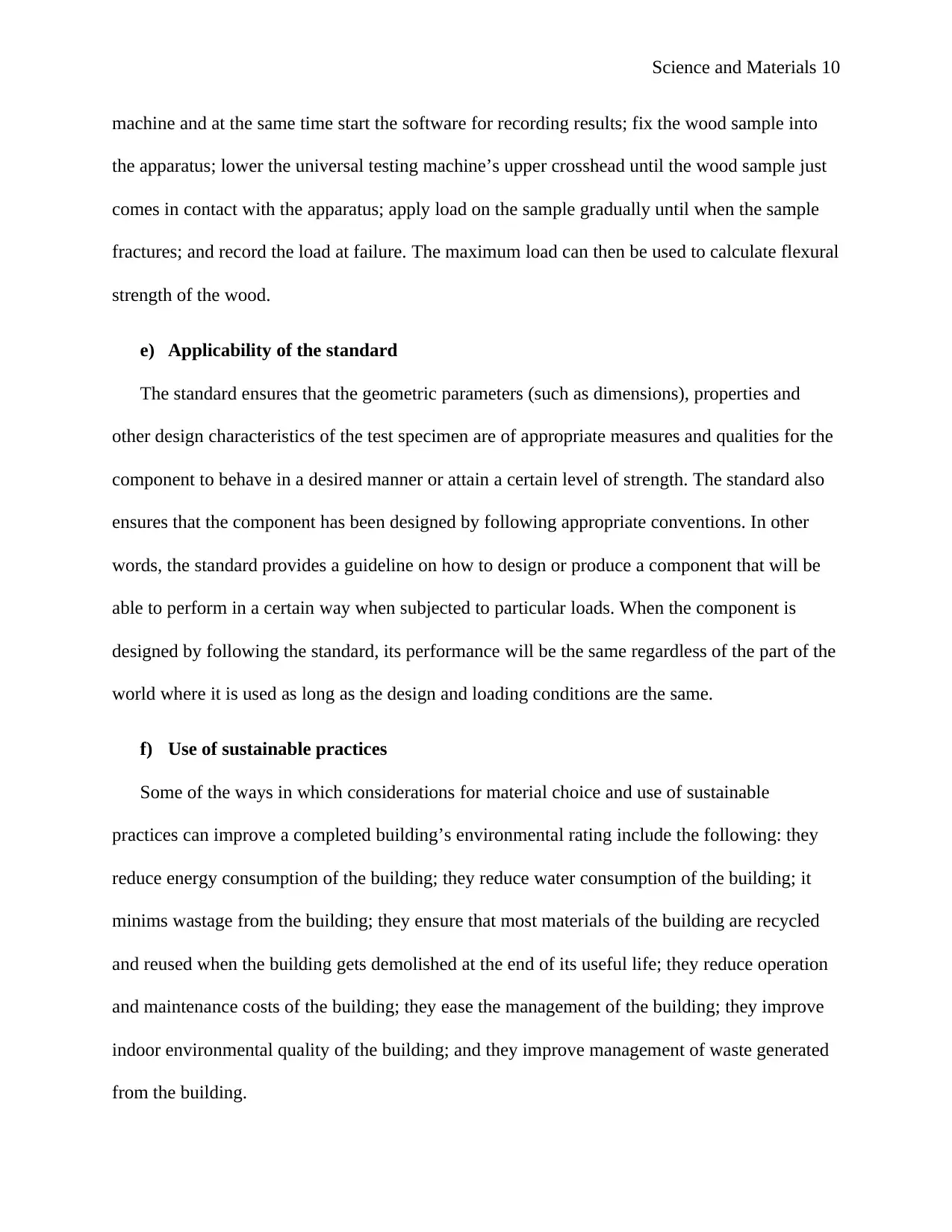
Science and Materials 10
machine and at the same time start the software for recording results; fix the wood sample into
the apparatus; lower the universal testing machine’s upper crosshead until the wood sample just
comes in contact with the apparatus; apply load on the sample gradually until when the sample
fractures; and record the load at failure. The maximum load can then be used to calculate flexural
strength of the wood.
e) Applicability of the standard
The standard ensures that the geometric parameters (such as dimensions), properties and
other design characteristics of the test specimen are of appropriate measures and qualities for the
component to behave in a desired manner or attain a certain level of strength. The standard also
ensures that the component has been designed by following appropriate conventions. In other
words, the standard provides a guideline on how to design or produce a component that will be
able to perform in a certain way when subjected to particular loads. When the component is
designed by following the standard, its performance will be the same regardless of the part of the
world where it is used as long as the design and loading conditions are the same.
f) Use of sustainable practices
Some of the ways in which considerations for material choice and use of sustainable
practices can improve a completed building’s environmental rating include the following: they
reduce energy consumption of the building; they reduce water consumption of the building; it
minims wastage from the building; they ensure that most materials of the building are recycled
and reused when the building gets demolished at the end of its useful life; they reduce operation
and maintenance costs of the building; they ease the management of the building; they improve
indoor environmental quality of the building; and they improve management of waste generated
from the building.
machine and at the same time start the software for recording results; fix the wood sample into
the apparatus; lower the universal testing machine’s upper crosshead until the wood sample just
comes in contact with the apparatus; apply load on the sample gradually until when the sample
fractures; and record the load at failure. The maximum load can then be used to calculate flexural
strength of the wood.
e) Applicability of the standard
The standard ensures that the geometric parameters (such as dimensions), properties and
other design characteristics of the test specimen are of appropriate measures and qualities for the
component to behave in a desired manner or attain a certain level of strength. The standard also
ensures that the component has been designed by following appropriate conventions. In other
words, the standard provides a guideline on how to design or produce a component that will be
able to perform in a certain way when subjected to particular loads. When the component is
designed by following the standard, its performance will be the same regardless of the part of the
world where it is used as long as the design and loading conditions are the same.
f) Use of sustainable practices
Some of the ways in which considerations for material choice and use of sustainable
practices can improve a completed building’s environmental rating include the following: they
reduce energy consumption of the building; they reduce water consumption of the building; it
minims wastage from the building; they ensure that most materials of the building are recycled
and reused when the building gets demolished at the end of its useful life; they reduce operation
and maintenance costs of the building; they ease the management of the building; they improve
indoor environmental quality of the building; and they improve management of waste generated
from the building.
Paraphrase This Document
Need a fresh take? Get an instant paraphrase of this document with our AI Paraphraser

Science and Materials 11
g) Maximum load of a column
Maximum load of a column is calculated using equation 1 below (known as Euler column
formula)
F= nπ ² EI
L ² …………………………………………………. (1)
Where F = maximum load, E = Young’s modulus, n = end conditions factor, I = moment of
inertia, and L = length of column.
In this case, E = 35GPa = 35 x 109 Pa (N/m2); L = 4m; End conditions factor = fixed at both
ends, n = 4; and I = π r 4
4 CITATION Engnd3 \l 1033 (Engineering ToolBox, (n.d.)) .
I =π (0.25¿¿ 4 )
4 =0.003068 m4 ¿
F=
4∗π2∗35 x 109 N
m2 ∗0.003068 m4
( 4 m)² =264,949.5 KN
Task 4
a) Accepted indoor environmental conditions
Indoor environments need to be created such that people can feel comfortable (Al horr, et al.,
2016). There are numerous environmental conditions that affect indoor comfort. The indoor
environmental conditions vary depending on the type or use and location of the building. Table 1
below shows the generally accepted indoor environmental conditions.
Table 1: Accepted indoor environmental conditions
Indoor environmental Accepted values
g) Maximum load of a column
Maximum load of a column is calculated using equation 1 below (known as Euler column
formula)
F= nπ ² EI
L ² …………………………………………………. (1)
Where F = maximum load, E = Young’s modulus, n = end conditions factor, I = moment of
inertia, and L = length of column.
In this case, E = 35GPa = 35 x 109 Pa (N/m2); L = 4m; End conditions factor = fixed at both
ends, n = 4; and I = π r 4
4 CITATION Engnd3 \l 1033 (Engineering ToolBox, (n.d.)) .
I =π (0.25¿¿ 4 )
4 =0.003068 m4 ¿
F=
4∗π2∗35 x 109 N
m2 ∗0.003068 m4
( 4 m)² =264,949.5 KN
Task 4
a) Accepted indoor environmental conditions
Indoor environments need to be created such that people can feel comfortable (Al horr, et al.,
2016). There are numerous environmental conditions that affect indoor comfort. The indoor
environmental conditions vary depending on the type or use and location of the building. Table 1
below shows the generally accepted indoor environmental conditions.
Table 1: Accepted indoor environmental conditions
Indoor environmental Accepted values
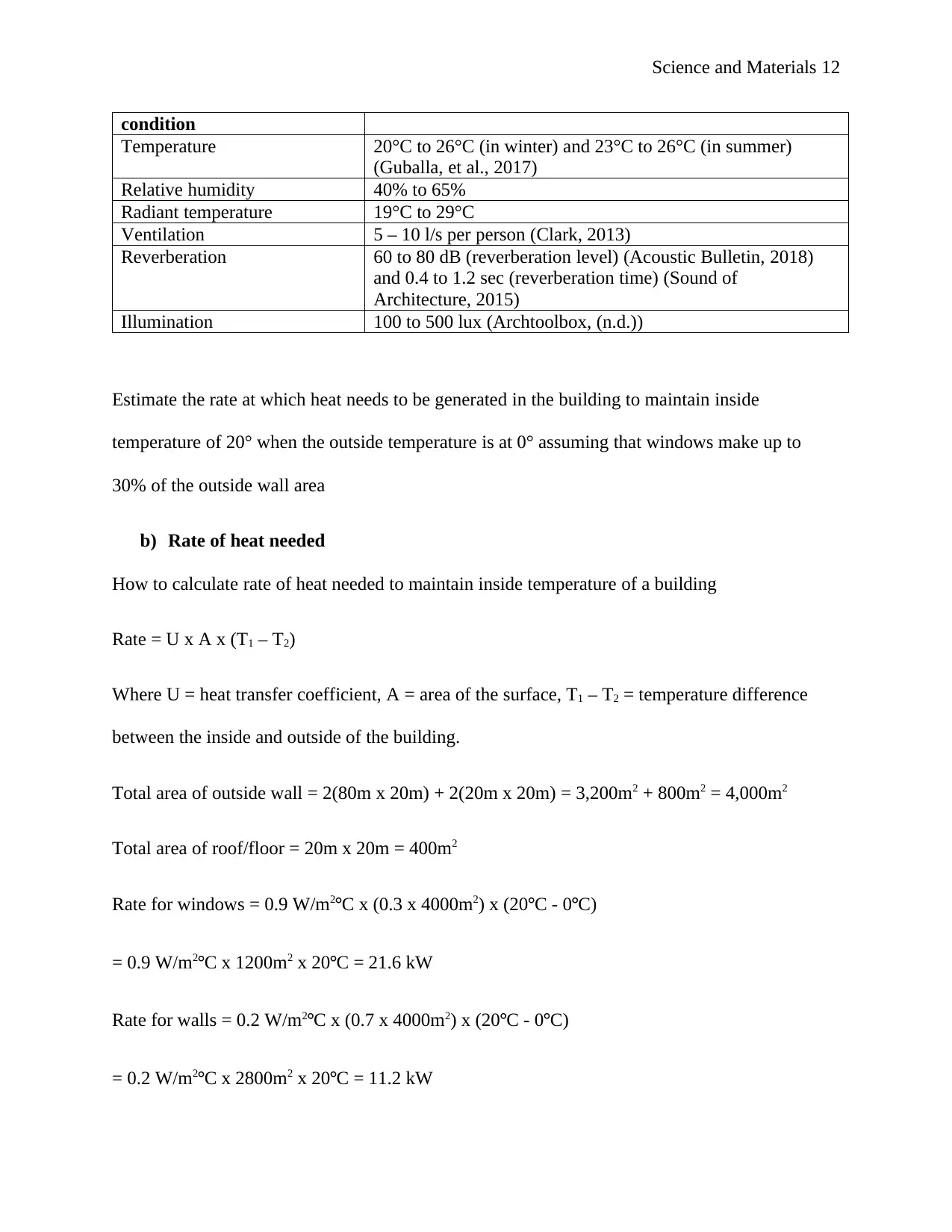
Science and Materials 12
condition
Temperature 20°C to 26°C (in winter) and 23°C to 26°C (in summer)
(Guballa, et al., 2017)
Relative humidity 40% to 65%
Radiant temperature 19°C to 29°C
Ventilation 5 – 10 l/s per person (Clark, 2013)
Reverberation 60 to 80 dB (reverberation level) (Acoustic Bulletin, 2018)
and 0.4 to 1.2 sec (reverberation time) (Sound of
Architecture, 2015)
Illumination 100 to 500 lux (Archtoolbox, (n.d.))
Estimate the rate at which heat needs to be generated in the building to maintain inside
temperature of 20° when the outside temperature is at 0° assuming that windows make up to
30% of the outside wall area
b) Rate of heat needed
How to calculate rate of heat needed to maintain inside temperature of a building
Rate = U x A x (T1 – T2)
Where U = heat transfer coefficient, A = area of the surface, T1 – T2 = temperature difference
between the inside and outside of the building.
Total area of outside wall = 2(80m x 20m) + 2(20m x 20m) = 3,200m2 + 800m2 = 4,000m2
Total area of roof/floor = 20m x 20m = 400m2
Rate for windows = 0.9 W/m2°C x (0.3 x 4000m2) x (20°C - 0°C)
= 0.9 W/m2°C x 1200m2 x 20°C = 21.6 kW
Rate for walls = 0.2 W/m2°C x (0.7 x 4000m2) x (20°C - 0°C)
= 0.2 W/m2°C x 2800m2 x 20°C = 11.2 kW
condition
Temperature 20°C to 26°C (in winter) and 23°C to 26°C (in summer)
(Guballa, et al., 2017)
Relative humidity 40% to 65%
Radiant temperature 19°C to 29°C
Ventilation 5 – 10 l/s per person (Clark, 2013)
Reverberation 60 to 80 dB (reverberation level) (Acoustic Bulletin, 2018)
and 0.4 to 1.2 sec (reverberation time) (Sound of
Architecture, 2015)
Illumination 100 to 500 lux (Archtoolbox, (n.d.))
Estimate the rate at which heat needs to be generated in the building to maintain inside
temperature of 20° when the outside temperature is at 0° assuming that windows make up to
30% of the outside wall area
b) Rate of heat needed
How to calculate rate of heat needed to maintain inside temperature of a building
Rate = U x A x (T1 – T2)
Where U = heat transfer coefficient, A = area of the surface, T1 – T2 = temperature difference
between the inside and outside of the building.
Total area of outside wall = 2(80m x 20m) + 2(20m x 20m) = 3,200m2 + 800m2 = 4,000m2
Total area of roof/floor = 20m x 20m = 400m2
Rate for windows = 0.9 W/m2°C x (0.3 x 4000m2) x (20°C - 0°C)
= 0.9 W/m2°C x 1200m2 x 20°C = 21.6 kW
Rate for walls = 0.2 W/m2°C x (0.7 x 4000m2) x (20°C - 0°C)
= 0.2 W/m2°C x 2800m2 x 20°C = 11.2 kW
⊘ This is a preview!⊘
Do you want full access?
Subscribe today to unlock all pages.

Trusted by 1+ million students worldwide
1 out of 16
Related Documents
Your All-in-One AI-Powered Toolkit for Academic Success.
+13062052269
info@desklib.com
Available 24*7 on WhatsApp / Email
![[object Object]](/_next/static/media/star-bottom.7253800d.svg)
Unlock your academic potential
Copyright © 2020–2025 A2Z Services. All Rights Reserved. Developed and managed by ZUCOL.





